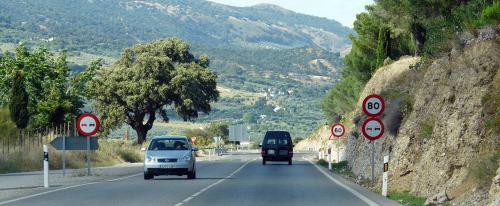MADRID—Anytime from age 18 onward, Spanish young adults endure a harrowing ordeal. They must sit for a written exam, notorious for the obscurity of its questions. It often takes place in dingy, Franco-era warehouses, overseen by gruff functionaries. Successful test-takers emerge with tears of joy and excited phone calls to friends and family.
Others cry tears of sorrow, resigning themselves to studying harder, even if they’re on their second, third, or tenth attempt. They need to get all but a handful questions correct to avoid failing. They steel themselves for another attempt and dread the money they will have to spend in the process.
For many, the exam will determine their social and economic mobility. It will also determine their literal mobility. It’s their driving test.
I wouldn’t have believed the depths of absurdity to which a developed country would sink in complicating such an essential rite of passage. But, separate accounts of this story confirm that the process of getting an American drivers license is, by comparison, scarcely more difficult than is signing up for an ArborBridge demonstration lesson.
An American friend of mine who lives in Madrid took the Spanish driving test recently. He's a math teacher at an international school and therefore knows a few things about administering exams. He said that his test included an unintelligible English translation and a near fistfight between a proctor and one of his fellow test-takers.
My friend’s girlfriend is a native Spaniard; she’s a nurse and is as bright as can be. She failed the driving test five times in her late teens.
There’s no indication that Spaniards are inherently worse drivers than are Americans. They just have a worse bureaucracy.
This is a particularly unfortunate state of affairs in a country that has arguably suffered more so than any other from the economic crisis of the late-2000s. Spanish unemployment is around 25%. Youth unemployment is more than twice as bad: 57%. Cronyism and graft reportedly run rampant in the Spanish public sector, impeding attempts at economic recovery.
It’s that much harder to get a job when you can’t even get to the interview. Moreover, it’s hard to inject money into the wider economy when you’ve blown 3,000 euro – as my friend’s girlfriend did – on repeated courses in driver’s ed.
Spanish youth, whose desperation is now treated like part of the national culture, are growing up in the impoverished shell of a bygone empire. Forget about sailing to the New World. Spanish kids can hardly get across town if they can’t recall the maximum allowable speed at which a three-wheeled vehicle can travel with two passengers on a highway.
The Spanish university entrance exam is not much better. As in many other countries, the Selectividad comprises the entire application to Spanish universities. It’s a massive, challenging exam that students spend months studying for. Fortunately, it leads to some excellent universities. Unfortunately, those universities are in Spain.
What I have heard from nearly everyone here – college counselors, parents, and my friends alike – is that ambitious Spanish students are desperate to get out of Spain. For all the usual reasons – good schools, liberal arts curricula, English-language immersion, and abundant choices – the United States is a prized destination, even when students are coming from such a developed, cultured, and still relatively wealthy place.
Spanish high schools are increasingly adding English-language and International Baccalaureate programs. These schools are also becoming increasingly interested in providing SAT preparation. Spanish application numbers to the U.S. are creeping up. In 2006-2007, right before the crisis, 3,575 Spaniards were studying in the U.S.; in 2011-2012 there were 4,924. (Meanwhile, Spain remains a huge draw for American students studying abroad, with over 25,000 last year.)
Those numbers would likely be much higher were it not for two factors.
First, Spanish families tend to be tightly knit. Many Spanish college students choose universities in their home cities and often live at home, presumably with later curfews than they had in high school. They have little tradition of “going away to school.” You’d probably stick around too if your hometown was as lovely as is Valencia, Barcelona, or Madrid.
Second, the very economic crisis that inspires Spanish youth to apply abroad makes paying for foreign tuition ($30,000 and up in the U.S.) nearly impossible for many families. Whereas many American universities rely on full-paying students from countries like China, Spanish students frequently seek financial aid.
Even so, many families are still willing to make the investment for the sake of what is, arguably, the finest undergraduate system in the world and, presumably, one of the finest opportunities for career training in the world. Whether Spanish students will return to Spain and fuel its recovery, seek employment and a green card in the U.S., or find their fortune elsewhere in the world, success awaits those who are diligent.
One thing is for certain: a good education, whether found in Spain, the United States, or elsewhere, will take them further than any drivers license ever could.






